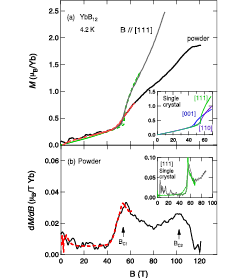Metamagnetism in the Kondo Insulator YbB12 at Ultrahigh Magnetic Fields of up to 120 T
Y. Matsuda and Kindo Groups
Kondo insulator is a fascinating group of materials. When strong interactions between magnetic ions and itinerant band electrons exist, the metallic ground state with heavy mass of the quasi particle may appear. However, in reality, a limited number of materials exhibit insulating ground state due to yet-to-be-defined reason and are termed Kondo insulators. The energy gap opens at a low temperature and simultaneously the magnetic moments are screened most probably due to the Kondo effect. The resultant ground state of the Kondo insulator is non-magnetic insulating state. One may naturally think that the Kondo effect would be suppressed by a high enough magnetic field. Hence, high-magnetic-field experiments on the Kondo insulator is intriguing; the electronic and magnetic properties are expected to change significantly by applying the high magnetic field.

Fig. 1. (a) Magnetic field dependence of the magnetization (M) of YbB12. The red-dashed and black-solid curves denote the magnetization of powder sample measured by a non-destructive pulsed magnet and that by HSTC, respectively. The green-dashed and gray-solid curves denote the M of a single crystal measured by a non-destructive pulse magnet and that using the HSTC, respectively. The inset shows the M curves of the single crystals with different magnetic field directions. (b) The field derivative of the magnetization (dM/dB) curves for the results of non-destructive pulse magnet (red-dashed curve) and that by the single-turn coil method (black solid curve). The inset shows dM/dB for the single crystal in the B//[111] direction. The green-solid curve was obtained with a non-destructive magnet and the gray-solid curve was obtained with the HSTC.
YbB12 is a canonical Kondo insulator and known to show clear insulator-metal (IM) transition at around 50 T [1]. At the field-induced IM phase transition, a steep increase of the magnetization also appears, and the phenomenon is often referred as metamagnetism or metamagnetic transition. The observed magnetization at 50 T, however, is smaller than half of the expected saturation magnetization. Higher magnetic fields are necessary to uncover the peculiar electronic and magnetic properties of YbB12.
Recently, we have conducted magnetization experiments on YbB12 in ultrahigh fields of up to 120 T. The horizontal-type single-turn coil (HSTC) is employed for the field generation. Figure 1 (a) shows the obtained magnetization curves; the thick black line and grey thin line represent the magnetization of the powdered sample and that of a single crystal, respectively. The magnetization curves of the single crystal with different directions of the applied magnetic field are shown in the inset of Fig. 1(a). In addition to the previously known metamagnetism around 50 T, another metamagnetic transition is observed in the powder sample at around 102 T [2]. This phenomenon is seen more clearly in the field variation of dM/dB (field derivative of the magnetization) as shown in Fig. 1(b). The metamagnetic transitions are observed as peak structures; there are broad but distinct two peaks at 55 and 102 T.
The observed successive two metamagnetic transitions can be interpreted as energy gap closing process. [1,2] In terms of the band magnetism, the metamagnetic transition occurs when the density of states (DOS) takes peak structure near Fermi energy at certain magnetic field. The two metamagnetic transitions indicate that there are multi-pseudo gap structures in the electronic state of YbB12. Similar multi-pseudo gap structures have been suggested to exist in the Kondo semimetal CeNiSn [3], and the Kondo effect is theoretically predicted to collapse at the second metamagnetic transition when the larger pseudo-gap closes due to the Zeeman effect. Similar phenomenon probably takes place in YbB12. The insulating state transforms to metallic state at around 50 T and the heavy fermion phase appears at magnetic fields in the range from 50 to 102 T. At higher fields exceeding 102 T, it is expected that the Kondo effect eventually vanishes and a normal metal state with saturated magnetization realizes. To validate this picture, further studies with single crystals are planned to be performed.
References
- [1] K. Sugiyama, F. Iga, M. Kasaya, T. Kasuya, and M. Date, J. Phys. Soc. Jpn. 57, 3946 (1988).
- [2] T. T. Terashima, A. Ikeda, Y. H. Matsuda, A. Kondo, K. Kindo, and F. Iga, J. Phys. Soc. Jpn. 86, 054710 (2017).
- [3] T. Yamada and Y. Ono, Phys. Rev. B 85, 165114 (2012).
